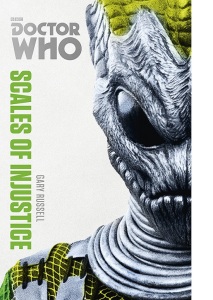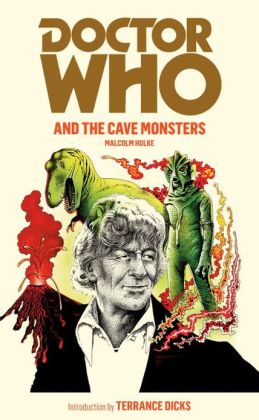The Doctor investigates another colony of homo reptilia, while Liz is drawn into a conspiracy involving corrupt Government officials and the misuse of alien technology.
The new cover which adorns this reprint of a 1996 Virgin Missing Adventure is a little misleading. The Silurians the Doctor encounters in this story are not the ones that viewers of twenty-first century Doctor Who will be familiar with; they were unknown to humankind when this volume was written. Neither are they the same as the ones the Third Doctor encountered in Doctor Who and the Silurians. As well as explaining the differences in Silurian and Sea Devil appearance between the Pertwee-era and Warriors of the Deep (and how the Doctor recognises a Myrka), the 21st century Silurians are also cleverly anticipated in a scene which the Doctor encounter holographic artworks “of hybrids or sub-species that he had not yet encountered.”
Gary Russell has crafted a tale set between the season seven finale Inferno and the following year’s Terror of the Autons. He provides the farewell for Liz Shaw that she never got on-screen, a turbulent home life for the Brigadier and has Mike Yates earning his commission.
There is something quite satisfying about the BBC re-publishing such a continuity-heavy work as this. There’s a confidence now that fans who started watching 2005-onwards have gone back and discovered the first twenty-six years worth of adventures. This is a treasure-trove of Doctor Who lore, essentially creating an alternative history of the United Kingdom. Pertwee’s first, Earthbound, season is the starting point, into which Russell weaves stories from throughout Doctor Who‘s original run: The War Machines, The Invasion, Time-Flight, Remembrance of the Daleks and The Curse of Fenric are all referenced. With Malcolm Hulke’s brilliant novelisation of his own Doctor Who and The Silurians, called Doctor Who and The Cave Monsters, being re-released last year with a handsome new cover, it will pay dividends to anyone who has read that volume. Russell expands on the rich civilisation that Hulke created in this book; just as Steven Moffat reportedly directed Chris Chibnall to it when writing The Hungry Earth and Cold Blood.
Sir John Sudbury and C19, mentioned in the Fifth Doctor story Time-Flight, are given a place in the wider context of UNIT and the British Government. There is also an institution called The Glasshouse, responsible for the rehabilitation of UNIT soldiers and other victims after the Doctor has defeated an alien menace. We know from Terror of the Autons, where he grumbles that the Nestene sphere should have been destroyed, that he has no say (or that much interest) in the fate of all this stuff; but logically the Government would. This isn’t really explored on television until Torchwood turns up in the Tennant era. Even more corrupt and self-serving than the Glasshouse though, are The Vault, run by an unseen former electronics magnate (heavily implied to be Tobias Vaughn).
Gary Russell does not mess about with the dating of the UNIT-era. Rather than leave it ambiguously in the near-future, or joke about it as the twenty-first century stories have done, he specifically has the setting as the 1970s. The cinema of the seventies was full of political thrillers like All The Presidents Men, The Parallax View and The Manchurian Candidate. On TV Doctor Who would not tap this vein until The Deadly Assassin, but reflecting the times, and the cultural output of the times, is something the series has always done. (Mostly at this time, it was the growing ecological awareness that underpinned many of the stories, with producer Barry Letts’ hand a huge influence). As Erik and Sean point out in their review of this book on their excellent Doctor Who Book Club Podcast, none of the villains here are caught or punished; which fits with those themes of vast official deception and corruption, at untouchable levels of power.
Viewers of the current series will recognise the character of Kate Lethbridge-Stewart, from The Power of Three and The Day of the Doctor. Here she is a five year-old girl, watching as her parent’s marriage buckles under the pressure of her father’s job. Russell deftly adds depth to the man, in a way which doesn’t diminish or change the character. He introduces the dimension of a home life, and it’s easy to imagine the Brig compartmentalising these two lives. Due to the Official Secrets Act, Fiona, his wife doesn’t even know he’s a soldier!
 Scales of Injustice is a rich, absorbing read, with many plot strands and characters. The Doctor himself, after a traditional opening with Liz and the Brigadier, is absent for large parts of the book. This is not to the detriment of the story, however. Happily there is further reading that can be enjoyed after finishing the story, as it shares elements with spin-off book Who Killed Kennedy, and has two sequels featuring the Sixth Doctor: Business Unusual and Instruments of Darkness.
Scales of Injustice is a rich, absorbing read, with many plot strands and characters. The Doctor himself, after a traditional opening with Liz and the Brigadier, is absent for large parts of the book. This is not to the detriment of the story, however. Happily there is further reading that can be enjoyed after finishing the story, as it shares elements with spin-off book Who Killed Kennedy, and has two sequels featuring the Sixth Doctor: Business Unusual and Instruments of Darkness.
.
Order Scales of Injustice from Amazon:
On Kindle:
Doctor Who: The Scales of Injustice: The Monster Collection Edition
Audiobook:




